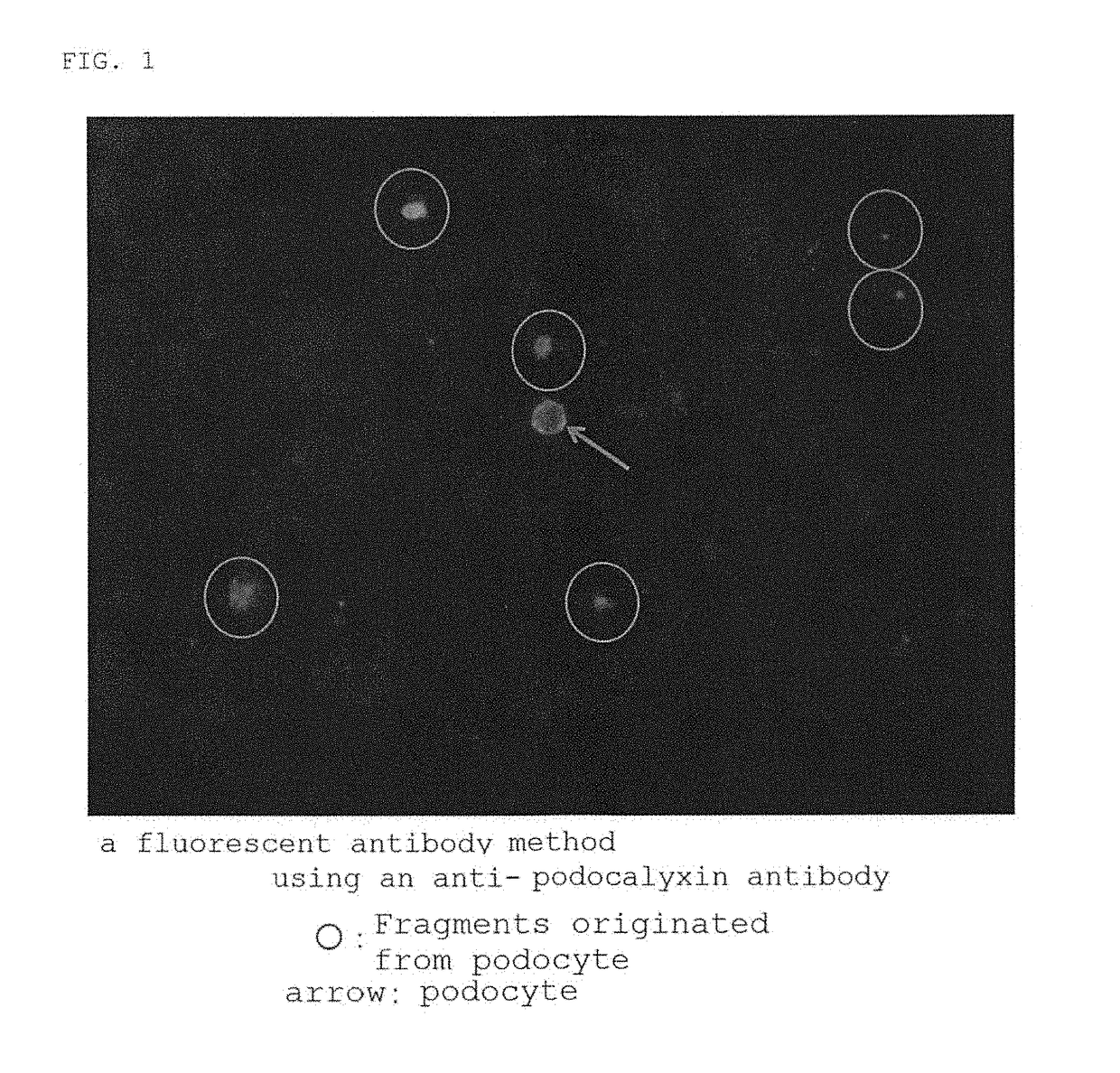Method for estimating number of podocytes in urine
a technology of urinary podocytes and podocytes, which is applied in the direction of material analysis, biological material analysis, instruments, etc., can solve the problem of cardiovascular disease risk factor ckd, and achieve the effects of predicting the prognosis of renal disease, and reducing the risk factor of ckd
- Summary
- Abstract
- Description
- Claims
- Application Information
AI Technical Summary
Benefits of technology
Problems solved by technology
Method used
Image
Examples
example 1
Preparation of Urinary Sediment Sample Liquid
[0087]A urinary sediment sample liquid was prepared by treating urine collected from a test subject in the following manner.
[0088](1) 1,000 μL of the urine and 111 μL of a treatment liquid 1 (2 M TES-NaOH (pH 7.0), 0.2 M EDTA) were mixed with each other.
[0089](2) The resultant mixed liquid was centrifuged (1,500 g, 4° C., 5 min).
[0090](3) The supernatant after the centrifugation was discarded, and a pellet (sediment) was obtained. To the pellet, 100 μL of a treatment liquid 2 (200 mM TES-NaOH (pH 7.0), 20 mM EDTA, 0.2% (Vol. / Vol.) Triton X-100) was added, and the mixture was stirred with Voltex.
[0091](4) The mixed liquid obtained after the stirring was centrifuged (15,000 g, 4° C., 5 min).
[0092](5) After the centrifugation, the supernatant was collected, and used as the urinary sediment sample liquid.
example 2
Measurement of Podocalyxin Excretion Amount in Urinary Sediment in Urinary Sediment Sample Liquid
[0093]A podocalyxin concentration was measured using two kinds of anti-human podocalyxin monoclonal antibodies. Those two kinds of antibodies respectively recognize two different epitopes of human podocalyxin, and are respectively an anti-human podocalyxin monoclonal antibody a (hereinafter referred to simply as “antibody a”) and an anti-human podocalyxin monoclonal antibody b (hereinafter referred to simply as “antibody b”). In this Example, an antibody a-immobilized microtiter plate (split type micro plate GF8 high: Nunc), and a horseradish peroxidase-labeled antibody b (hereinafter abbreviated as “HRP”) were used.
[0094]First, 100 μL of the urinary sediment sample liquidprepared in Example 1 described above was added to wells of the antibody a-immobilized microtiter plate. The plate was left to stand still at 37° C. for 1 hour, and then the urine sample solution was removed from the we...
example 3
Measurement of Podocalyxin Excretion Amount in Urinary Sediment Sample Liquid of Diabetic Nephropathy Patient
[0096]With use of urine specimens collected from. 32 diabetes patients having urine protein (microalbuminuria: 17 patients, macroalbuminuria: 15 patients), urinary sediment sample liquids were prepared by the method of Example 1. With use of the resultant urinary sediment sample liquids, podocalyxin in the urinary sediment sample liquid derived from each diabetes patient was detected and a podocalyxin excretion amount was calculated by the method of Example 2. The results are shown in Table 1.
TABLE 1Podocalyxin Excretion Amount in Urinary Sedimentof Diabetic Nephropathy Patient having ProteinuriaPCX / CreNo.(ng / mgCre) 12.0 20.0 32.8 41.5 52.2 62.3 71.9 85.8 91.3106.21115.5121.71313.0140.0152.3161.3172.7186.0192.6201.1210.6228.5230.0247.9250.12621.0270.02828.8291.6304.83142.8325.9Average (microalbuminuria)3.7Average (macroalbuminuria)8.8Average (overall)6.07No. 1 to 17: diabetic...
PUM
| Property | Measurement | Unit |
|---|---|---|
| volume | aaaaa | aaaaa |
| pH | aaaaa | aaaaa |
| volume | aaaaa | aaaaa |
Abstract
Description
Claims
Application Information
 Login to View More
Login to View More - R&D
- Intellectual Property
- Life Sciences
- Materials
- Tech Scout
- Unparalleled Data Quality
- Higher Quality Content
- 60% Fewer Hallucinations
Browse by: Latest US Patents, China's latest patents, Technical Efficacy Thesaurus, Application Domain, Technology Topic, Popular Technical Reports.
© 2025 PatSnap. All rights reserved.Legal|Privacy policy|Modern Slavery Act Transparency Statement|Sitemap|About US| Contact US: help@patsnap.com

